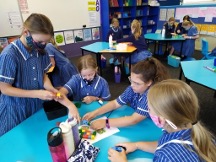In the depths of Southland, a perceived traditional school took a leap into current research-based practice with their teaching and learning pedagogy, and they’re not looking back.
Established by the Anglican Church in 1917, St John’s Girls’ School is an integrated full primary school with a roll of 145 girls. It prides itself on its traditions, Christian values and high expectations. Old-fashioned, however, it is not.
The school was producing pleasing results across the curriculum and by all standards, things were going particularly well. What had become apparent to staff a number of akonga were not on the path to reaching their potential.
The New Zealand Curriculum requires schools to… ‘support and empower all students to learn and achieve personal excellence…’ Through a range of professional development it became apparent that their practice of ability grouping was restricting the content and coverage of the New Zealand curriculum to some learners, and preventing all girls from reaching their potential.
The school embarked on a period of exploration and wandering, which at times felt uncertain and risky. Leading the charge was Sharon Taylor, a forever reflective teacher who’d had a chord struck at a conference on ‘Leaders influencing teachers’ high expectations’ in the year prior.
This was supported by the principal at the time Brenda Mackay, and the Mathematics Facilitator from the University of Otago, Averil Lee. The learning during this period was significant.
Excitement is infectious and before long another teacher, now Principal, Nathan Hughes, was inspired by what he was seeing happening in Taylor’s Year 6 classroom. After 18 months of exploration in 2021 the whole school made a commitment to remove streaming throughout the school for mathematics.
There was a shift from prioritising academic success, to building a culture of ‘can-do, risk-taking and a school-wide understanding that making mistakes creates new learning pathways. “The girls will tell you that the acronym of FAIL means ‘First Attempt in Learning”, Taylor and Hughes say.
What actions were implemented at St John’s?
● Low floor high ceiling rich tasks are explored collaboratively.
● Differentiated knowledge tasks offered to all students.
● Connection between and communication of the concepts in mathematics are made explicit.
● Teachers aim to talk for 10% of each lesson.
● Depth of understanding is more important than speed’ is promoted as the norm.
● Maths activities are about learning, rather than performance.
● All staff completed Jo Boaler’s Mindset Maths course (Stanford University).
● Mixed ability groups are used and change regularly.
Feedback from the teachers is exciting. They now see how streaming is in fact detrimental.
“The decision to de-stream required us to find open-ended, low-floor high-ceiling tasks, making learning accessible to all the students.” “Opportunities had to be provided for student driven whole class discussions.”
“‘I am using the mindset approach across all areas of the curriculum; how we communicate with each other, respond to questions, work in groups and learn from each other.”
“‘I especially like that this way of teaching gives the girls confidence in sharing their ideas, and also to justify their answers. This is a great skill to learn and lends itself to NCEA requirements in terms of justification and explanation.”
“New-found confidence is leading to greater student engagement and effective team problem solving.”
“The girls are more willing to make mistakes, and talk about different ways to solve problems”.
It was important to gain the support of the school community. When the school held a whanau information evening, there was a range of opinions coming through the door. Following careful explaining and modelling of tasks those present set about problem solving. Then the feedback started to come from the floor.
“Why weren’t we taught like this when I was at school?”
“This actually helps us to figure out WHY we are doing something, rather than just having to hear it and remember it.”
“I never shared my ideas at school when I was young. I was always too afraid I’d be wrong. I like that there isn’t only one correct way.”
Student agency is taken seriously at St John’s Girls’ School. The teachers gather the voice of their akonga:
“I like working on and learning new strategies in maths, and how we focus on one concept for our big idea/s.”
“‘I also enjoy how you get us to work in our groups and change tables rather than us being with certain people each term. So, we get to be with everyone.’”
“I used to think I wasn’t good at maths. Now I know that there are a lot of different ways to solve a problem. I will get there but it might not be the first time.’”
“If you make a mistake everyone will help you solve it.’”
Students achievement data has continued to be high throughout the shift to de-streaming and working in mixed ability groups. What has increased considerably is the disposition of the girls.
“This is a journey, and while we are well down the path, we’ve a considerable way to go”, Principal Nathan Hughes said. “What we certainly won’t be doing is putting a student in the orange triangle group, and expecting their achievement to match what you’d expect of a mid-range group.” “The limits are gone. In fact, the sky’s the limit!”
De-streaming needs to start at Primary School level and St John’s Girls’ School, in Invercargill, is well and truly on the right path towards providing equitable opportunities for all of their students.
Averil Lee
Mathematics Facilitator
Education Support Services
University of Otago
De-streaming mathematics at St John’s Girls’ School, Invercargill – Averill Lee



